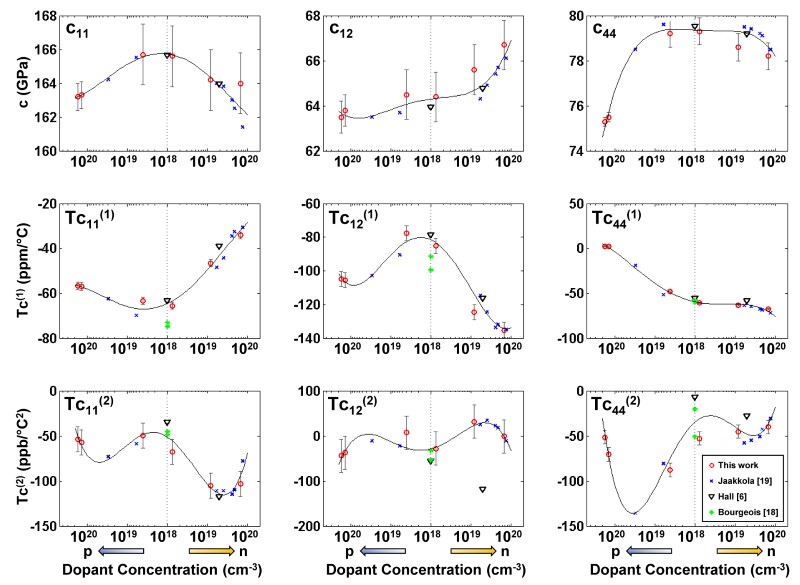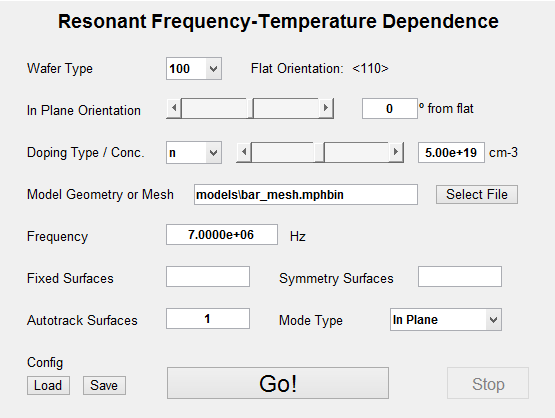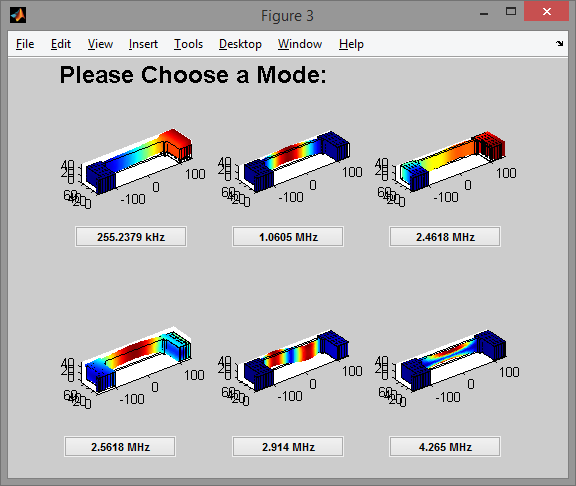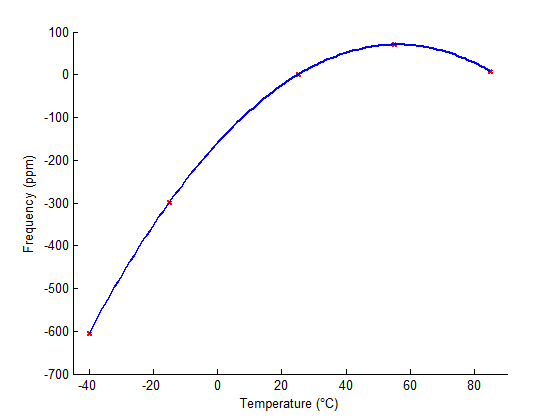Predicting f-T Characteristics of Resonators in Doped Silicon
Eldwin J. Ng
[Based JMEMS paper: "Temperature Dependence of the Elastic Constants of Doped Silicon" (Open Access)]
Since the frequency of an acoustic silicon resonator is strongly dependent on the elastic constants, the f-T dependence of a resonator can be predicted using knowledge of the elastic constants and their temperature dependences. From work done in our group [1] and other groups (VTT [2], CSEM [3], and IBM [4]), the doping and temperature dependence of the elastic constants of silicon have been extracted: p-type up to 1.75e20cm-3, and n-type up to 7.5e19cm-3. These extracted values (up to 2nd order, as shown below in Fig. 1, with least-squares fits to 4th order polynomials) can be used in conjunction with finite element analysis to simulate frequency-temperature dependences of doped silicon resonators.

Figure 1. The doping dependence of the elastic constants of silicon (first row) and
their temperature coefficients (second row: first order, third row: second order).
With fits to the elastic constants and their temperature coefficients across the different dopings, the f-T dependence of any doping level within the given range can be predicted for arbitrary resonant mode shapes using finite element analysis. COMSOL with MATLAB LiveLink is used here and the code is provided in the download section below.
:: Introduction
The frequency-temperature (f-T) dependence of monocrystalline silicon resonators is strongly affected when the silicon lattice is heavily doped with either p- or n-type dopants. This dependence is also dependent on the resonant mode shape and orientation: some common resonators and their f-T dependence on the doping is shown in [1]. The code available on this page allows for the prediction of the f-T characteristic of an arbitrary resonator in heavily doped silicon when operated in the linear regime.Since the frequency of an acoustic silicon resonator is strongly dependent on the elastic constants, the f-T dependence of a resonator can be predicted using knowledge of the elastic constants and their temperature dependences. From work done in our group [1] and other groups (VTT [2], CSEM [3], and IBM [4]), the doping and temperature dependence of the elastic constants of silicon have been extracted: p-type up to 1.75e20cm-3, and n-type up to 7.5e19cm-3. These extracted values (up to 2nd order, as shown below in Fig. 1, with least-squares fits to 4th order polynomials) can be used in conjunction with finite element analysis to simulate frequency-temperature dependences of doped silicon resonators.

Figure 1. The doping dependence of the elastic constants of silicon (first row) and
their temperature coefficients (second row: first order, third row: second order).
With fits to the elastic constants and their temperature coefficients across the different dopings, the f-T dependence of any doping level within the given range can be predicted for arbitrary resonant mode shapes using finite element analysis. COMSOL with MATLAB LiveLink is used here and the code is provided in the download section below.
:: Requirements
- MATLAB 2012 or 2013 (May work on other versions but only tested with these)
- COMSOL 4.3 or 4.4 with MATLAB LiveLink. (May work on other versions but only tested with these)
- COMSOL model of resonant device. Can be a geometry, a mesh (.mphbin), or a Matlab code (.m) for creating the geometry.
:: How to Use
 1] The GUI provided allows for several settings to be chosen. Pick the wafer crystal orientation, doping type and concentration, and input your COMSOL model of the geometry. Enter the expected resonant frequency and apply the boundary conditions on the surfaces.
1] The GUI provided allows for several settings to be chosen. Pick the wafer crystal orientation, doping type and concentration, and input your COMSOL model of the geometry. Enter the expected resonant frequency and apply the boundary conditions on the surfaces.
 2] The surface index numbers can be picked within the COMSOL GUI. Note these numbers and input them into the various fields above.
2] The surface index numbers can be picked within the COMSOL GUI. Note these numbers and input them into the various fields above.
 3] You may have to pick the desired mode if you did not specify a surface of maximal displacement to automatically track.
3] You may have to pick the desired mode if you did not specify a surface of maximal displacement to automatically track.
 4] Press "Go!" to run the simulation and the predicted f-T dependence (to second order) of the resonant mode will be generated.
4] Press "Go!" to run the simulation and the predicted f-T dependence (to second order) of the resonant mode will be generated.
:: Download
ResonatorSim v1.01 (8/28/16)
Updated with gas damping quality factor estimation and frequency response plotting
 User Guide
User Guide
 Matlab code for COMSOL
Matlab code for COMSOL
Updated with gas damping quality factor estimation and frequency response plotting
fTpred v0.1 (5/14/14)
Initial release, beta version that needs testing
 User Guide
User Guide
 Matlab code for COMSOL (Beta!)
Matlab code for COMSOL (Beta!)
Initial release, beta version that needs testing
:: Contact
Feedback and comments are welcome!Eldwin (eldwin :at: mems.stanford.edu)
:: References
[1] Eldwin J. Ng, Vu A. Hong, Yushi Yang, Chae Hyuck Ahn, Camille L. M. Everhart, and Thomas W. Kenny, "Temperature Dependence of the Elastic Constants of Doped Silicon," Journal of Microelectromechanical Systems, Vol. 24, No. 3, pp. 730-741, Jun 2015.
[2] A. Jaakkola, M. Prunnila, T. Pensala, J. Dekker, and P. Pekko, "Determination of Doping and Temperature Dependent Elastic Constants of Degenerately Doped Silicon from MEMS Resonators," arXiv: 1401.1363 [cond-mat.mtrl-sci], 2014.
[3] C. Bourgeois, E. Steinsland, N. Blanc, and N. F. deRooij, "Design of Resonators for the Determination of the Temperature Coefficients of Elastic Constants of Monocrystalline Silicon," IEEE International Frequency Control Symposium 1997, pp. 791-799, 1997.
[4] J. J. Hall, "Electronic Effects in Elastic Constants of N-Type Silicon," Physical Review, vol. 161, pp. 756-761, 1967.
[2] A. Jaakkola, M. Prunnila, T. Pensala, J. Dekker, and P. Pekko, "Determination of Doping and Temperature Dependent Elastic Constants of Degenerately Doped Silicon from MEMS Resonators," arXiv: 1401.1363 [cond-mat.mtrl-sci], 2014.
[3] C. Bourgeois, E. Steinsland, N. Blanc, and N. F. deRooij, "Design of Resonators for the Determination of the Temperature Coefficients of Elastic Constants of Monocrystalline Silicon," IEEE International Frequency Control Symposium 1997, pp. 791-799, 1997.
[4] J. J. Hall, "Electronic Effects in Elastic Constants of N-Type Silicon," Physical Review, vol. 161, pp. 756-761, 1967.
Last updated on: Jul 11 2014